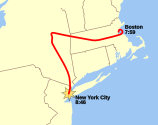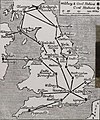Portal:Aviation
| Main page | Categories & Main topics |
|
Tasks and Projects |
The Aviation Portal

Aviation includes the activities surrounding mechanical flight and the aircraft industry. Aircraft includes fixed-wing and rotary-wing types, morphable wings, wing-less lifting bodies, as well as lighter-than-air aircraft such as hot air balloons and airships.
Aviation began in the 18th century with the development of the hot air balloon, an apparatus capable of atmospheric displacement through buoyancy. Some of the most significant advancements in aviation technology came with the controlled gliding flying of Otto Lilienthal in 1896; then a large step in significance came with the construction of the first powered airplane by the Wright brothers in the early 1900s. Since that time, aviation has been technologically revolutionized by the introduction of the jet which permitted a major form of transport throughout the world. (Full article...)
Selected article
The aircraft crashed into the North Tower of the World Trade Center at 08:46 local time; the impact killed all 92 people aboard, including the hijackers. Many people in the streets witnessed the collision, and Jules Naudet captured the impact on video. News agencies began to report on the incident soon after and speculated that the crash had been an accident. The impact and subsequent fire caused the North Tower to collapse, which resulted in thousands of additional casualties. During the recovery effort at the World Trade Center site, workers recovered and identified dozens of remains from Flight 11 victims, but many other body fragments could not be identified. (Full article...)
Selected image
Did you know
...that a Fairchild C-119 Flying Boxcar was used in the 2004 film Flight of the Phoenix? ...that Cornelius Vanderbilt Whitney was only twenty-eight years old when he helped found Pan American World Airways? ... that the price war started by Color Air in 1998 led to its bankruptcy after 14 months?
General images -
In the news
- May 29: Austrian Airlines cancels Moscow-bound flight after Russia refuses a reroute outside Belarusian airspace
- August 8: Passenger flight crashes upon landing at Calicut airport in India
- June 4: Power firm helicopter strikes cables, crashes near Fairfield, California
- January 29: Former basketball player Kobe Bryant dies in helicopter crash, aged 41
- January 13: Iran admits downing Ukrainian jet, cites 'human error'
- January 10: Fire erupts in parking structure at Sola Airport, Norway
- October 27: US announces restrictions on flying to Cuba
- October 3: World War II era plane crashes in Connecticut, US, killing at least seven
- September 10: Nevada prop plane crash near Las Vegas leaves two dead, three injured
- August 6: French inventor Franky Zapata successfully crosses English Channel on jet-powered hoverboard
Related portals
Associated Wikimedia
The following Wikimedia Foundation sister projects provide more on this subject:
-
Commons
Free media repository -
Wikibooks
Free textbooks and manuals -
Wikidata
Free knowledge base -
Wikinews
Free-content news -
Wikiquote
Collection of quotations -
Wikisource
Free-content library -
Wikiversity
Free learning tools -
Wikivoyage
Free travel guide -
Wiktionary
Dictionary and thesaurus
Selected biography
Selected Aircraft

The VZ-9 Avrocar (full military designation VZ-9-AV) was a Canadian VTOL aircraft developed by Avro Aircraft Ltd. as part of a secret U.S. military project carried out in the early years of the Cold War.[2] The Avrocar intended to exploit the Coandă effect to provide lift and thrust from a single "turborotor" blowing exhaust out the rim of the disk-shaped aircraft to provide anticipated VTOL-like performance. In the air, it would have resembled a flying saucer. Two prototypes were built as "proof-of-concept" test vehicles for a more advanced USAF fighter and also for a U.S. Army tactical combat aircraft requirement.[3] In flight testing, the Avrocar proved to have unresolved thrust and stability problems that limited it to a degraded, low-performance flight envelope; subsequently, the project was cancelled in 1961.
- Diameter:18 ft (5.486 m)
- Height: 3 ft 6 in (1.1 m)
- Engines: 3 x Turbomeca Marboré Continental J69-T-9
- Max Speed: 300 mph (482 km/h)
- First Flight: 12 November 1959
- Number built: 2
Today in Aviation
- 2010 – Two people were taken to Pensacola Naval Hospital for evaluation after landing an Air Force Beechcraft T-6 Texan II with the landing gear up. The names of the two crew members were not released after the 1300 hrs. incident, Pensacola Naval Air Station Public Affairs Officer Harry White said. Both people safely exited the plane, which landed at Forrest Sherman Field at the air station, White said. The aircraft and crew are assigned to the U.S. Air Force's 455th Flying Training Squadron at NAS Pensacola. The incident is being investigated by a board of officers, a NAS Pensacola news release said.
- 2009 – Interlink Airlines commences first every passenger flights from Wonderboom Airport outside Pretoria, South Africa. This is the first time the South African capital is connected to other centres in South Africa, instead of using OR Tambo International, Johannesburg. Flights started with 737-200 aircraft, although the runway is inadequate for these aircraft, so severe weight penalties, supposed to use BAe146 aircraft in the near future. Currently flights only to Cape Town and Durban.
- 2007 – A RAF HC.1 Puma ZA938 crashes. 2 SAS troopers die after the Puma troop transporter goes down in an urban area during a covert mission over Baghdad. Two other men from 22 Special Air Service Regiment were seriously injured in the crash although their condition is not thought to be life threatening. A further seven SAS and three RAF survived the impact and were later rescued by Coalition forces.[4][5][6]
- 2006 – Flying imams incident: Six Muslim imams were removed from US Airways Flight 300 to Phoenix, Arizona, at Minneapolis airport, because several passengers and crew members became alarmed by what they felt was suspicious behavior.The airport police and Federal Air Marshal agreed the circumstances were suspicious enough to warrant asking the men to leave the airplane. The airline has stated that the captain delayed takeoff and called airport security workers to ask the imams to leave the plane; the men refused, and that the captain then called police. The plane left without the imams on board about three hours later. The imams were detained, questioned, and then released.
- 1993 – Avioimpex Flight 110, a Yakovlev Yak-42, crashed on approach to Ohrid Airport in Macedonia. All 116 passengers and crew died as a result of the crash though one passenger did live for 11 days before succumbing to his injuries.
- 1991 – 1992 Azerbaijani Mil Mi-8 shootdown occurred when an Azerbaijani helicopter MI-8 military helicopter, carrying peacekeeping mission team consisting of observers from Russia, Kazakhstan, government officials from Azerbaijan and several journalists, was shot down by Armenian military forces near the Karakend village of Khojavend district in Nagorno-Karabakh, Azerbaijan. All 22 people (19 passengers and 3 crew) on board were killed in the crash.
- 1978 – The US Air Force orders development of the KC-10 Extender
- 1974 – Lufthansa Flight 540 crashes shortly after takeoff in Nairobi, Kenya; 59 of 157 on board are killed in the first crash of a Boeing 747.
- 1970 – The US Air Force and Army assault the Son Tay prison camp. No POWs are found.
- 1969 – Nigeria Airways Flight 825, a Vickers VC-10, crashes on approach to Lagos International Airport killing all 87 passengers and crew on board.
- 1967 – TWA Flight 128, a Convair 880, crashes in Constance, Kentucky on approach to Greater Cincinnati Airport, killing 70 of 82 persons on board.
- 1964 – Linjeflyg Flight 277, a Convair CV-340, crashes during the approach to Engelholm, Sweden, when, in instrument meteorological conditions, the crew abandons the set procedure and descends prematurely; 31 people are killed; 12 survive.
- 1963 – Tenth Lockheed U-2A, Article 350, 56-6683, delivered to the CIA on 24 April 1956, converted to U-2F by spring 1963; loaned to SAC for Cuba overflight missions, crashes into the Gulf of Mexico 40 miles (64 km) NW of Key West, Florida, killing pilot Capt. Joe Hyde, Jr. Pilot was returning from a Brass Knob mission and was hand-flying the aircraft back to Barksdale Air Force Base, Louisiana, at 69,000 feet (21,000 m) after failure of autopilot when it entered a flat spin and impacted in the Gulf. Wreckage retrieved from shallow water near Florida coast but ejection seat, seat pack and parachute missing - pilot never found.
- 1956 – It was announced that No. 435 (Transport) Squadron would move from Namao, Alberta to Capodichino, Naples, Italy to assist UNEF in the Egyptian-Israeli crisis.
- 1953 – Scott Crossfield flies the Douglas Skyrocket past Mach 2, the first flight to reach this speed. The world airspeed record is now set at 1,291 mph (2,078 km/h)
- 1949 – In the Hurum air disaster, an Aero Holland Douglas DC-3 crashes near Hurum, Norway, killing 34 of the 35 on board, including 25 Jewish children.
- 1948 – American balloon reaches a record height of 26 miles.
- 1945 – First flight of the Saab 91 Safir
- 1945 – The Boeing B-29 Pacusan Dreamboat sets a world nonstop distance record of 8,198 miles on a flight from Guam to Washington, D. C.
- 1943 – Battle of Tarawa - Operation Galvanic, the American invasion of the Gilbert Islands, begins with amphibious landings on Betio island at Tarawa Atoll and on Butaritari. The invasion is supported by 11 fleet and light aircraft carriers, eight escort aircraft carriers, and land-based aircraft of the U. S. Navy and the U. S. Army Air Force’s Seventh Air Force. To oppose them, the Japanese have only 46 aircraft in the Gilbert and Marshall Islands combined. During the evening, Japanese torpedo bombers hit the aircraft carrier USS Independence (CVL-22) with on torpedo, forcing her to withdraw for repairs but losing eight of their number; it is the only damage Japanese aircraft inflict on any American ship during the Gilbert Islands campaign.
- 1942 – The completion of the Alaska Highway allows the opening of the Northwest Staging Route (or Alaska-Siberia (“Alsib”) Lend-Lease route). It includes flights of American-made aircraft from Great Falls, Montana, to Fairbanks, Territory of Alaska, where they are turned over to Soviet pilots who fly them to Nome, Alaska, and then on to Siberia. By December 31, the United States will have supplied 148 aircraft to the Soviet Union via this route.
- 1919 – The first municipal airport in the United States opens in Tucson, Arizona and is still in use today.
References
- ^ Winnie Mae
- ^ Yenne 2003), pp. 281–283.
- ^ Milberry 1979, p. 137.
- ^ Thomas Harding (2007-11-22). "SAS men killed in Iraq as fourth Puma crashes". London: Telegraph. Retrieved 2007-11-22.
- ^ Matthew Moore, Sally Peck and agencies (2007-11-22). "Troops killed in Puma Iraq crash were SAS". London: Telegraph. Retrieved 2008-10-19.
- ^ Norton-Taylor, Richard (2007-11-22). "Two SAS soldiers die as RAF helicopter crashes in Iraq". London: Guardian. Retrieved 2008-10-19.
- Shortcuts to this page: Portal:Airplanes • P:AVIA






















































